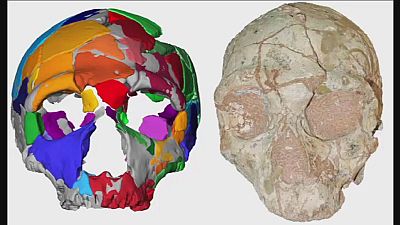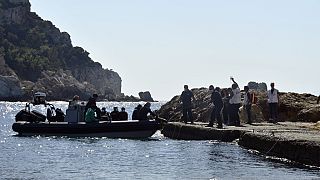Greece
These are the skulls discovered in the Greece.
They’re not a new discovery they were first discovered in in southern Greece in the 1970s, but scientists say they’ve only just been able to identify them accurately.
The researchers say the first, called Apidima 2 is Neanderthal.
But the partial remains of the second skull called Apidima 1 are causing more excitement.
Researchers at Tübingen University claim the remains are a sign of an early exit from Africa by our species.
After comparing details of the shape of the Apidima 1 cranial fragment to that of other fossils, the researchers concluded that it came from Homo sapiens.
The study published in the journal Nature was led by paleoanthropologist, Katerina Harvati.
The skull wasn’t prepared for inspection until sometime around 2000, and even then its fragmentary nature meant not a lot of attention was paid to it according to the team at Tübingen.
To identify what species it came from, the researchers made a virtual reconstruction of the fossil, using a mirror image to add a missing portion of it.
Then they had a computer make detailed comparisons to the shapes of other fossils. That pointed to the conclusion that it’s from Homo sapiens.
Harvati explains: “They were discovered encased in a rock called breccia, so they needed to be cleaned from this rock matrix and this was quite a difficult process. And the first specimen that was cleaned was Apidima 2 the Neanderthal specimen. And the second one, Apidima 1 took quite some time before it was cleaned it was only cleaned I think in the late 1990s or early naughts (2000s), but aside from this there were also quite fragmentary and Apidima 2 which is more complete was also quite distorted, so it was not so easy to study their anatomy properly without having a thorough reconstruction and this type of reconstruction was only, became only possible in the last few years with the advent of the virtual anthropology techniques.”
It’s new methods of reconstruction and dating which have made the findings possible.
“We can now produce a C.T. scan of these specimens and use virtual anthropology techniques and special software to try to restore the specimen to its original anatomy. So to try to move the little fragments to the original position, remove, virtually remove sediment from cracks and also mirror image let’s say aspects that are preserved on one side better but not on the other,” explains Harvati.
To establish the age of the skull, Harvati’s team analyzed isotopes of uranium in bits of bone that had been removed as rocky material attached to the fossil.
“To do this we applied uranium series dating method and the dates that were obtained were actually extremely interesting and surprising, because for Apidima 2 the Neanderthal, we confirmed the previous date, we obtained a very similar age of 170,000 years before present, Apidima 1, the homo sapiens specimen, this turned out to be much older and to be approximately 210,000 years before present.”
At least 210,000 years old, Apidima 1 is 16,000 or more years older than an upper jaw bone from an early modern human found in Israel that was reported last year.
It shows our species began leaving Africa much earlier than previously thought according to the scientists at Tübingen.
“It seems that this early expansion was actually earlier than we originally thought and that it reached all the way into the European continent which we did not suspect before,” says Harvati.
The travelers to Greece evidently left no descendants alive today.
Other research has established that the exodus from Africa that led to our takeover of Earth didn’t happen until much later.
Homo sapiens evolved more than 300,000 years ago in Africa, but the Greek population represented by the Apidima 1 skull are not direct ancestors of present day people.
Other research has established that the exodus from Africa that led to our takeover of Earth didn’t happen until much later, before that, the populations of our species that left Africa just died out.
Harvati says the evidence that our species had reached Greece at the time was initially a surprise, though with hindsight she says it’s not difficult to imagine that it would have happened.
Eric Delson of Lehman College in New York, who did not participate in the study, said he was “somewhat” surprised by the discovery but that “southeast Europe makes a lot of sense” for a finding that old. Now the question is what happened to these people, he said. Did Neanderthals out-compete them?
Harvati says the findings are important because of the questions they raise:
“Did they meet Neanderthals (ancesters of modern humans) were they able to interbreed with them. We have for example, some suggestions from ancient DNA genetic evidence that there was an ancient interbreeding event between Neanderthals and the population related to the ancestors of modern humans. Could it be that this is what we are seeing. Also what enabled these early expansions of humans, were they linked to climatic events, or technological developments. These are all questions for future research,” she says.
But some other scientists aren’t convinced the study conclusions are correct.
Warren Sharp, an expert on dating fossils at the Berkeley Geochronology Center in California, said he believed that the reported age of 210,000 years is “not well supported by the data.”
He believes the test results that led to it are imprecise and highly scattered, and rely on an unproven inference about the past uranium content of the bone samples, he said by email.
Another, Ian Tattersall of the American Museum of Natural History in New York called the case for identifying the fossil as Homo sapiens “pretty shaky.”
Its shape is suggestive, but it’s incomplete and it lacks features that would make the identification firmer, he said in an email.
In response, Harvati said the back of the skull is very informative for differentiating Homo sapiens from Neanderthals and other related species, and that several lines of evidence support the identification.
She is not yet sure whether scientists will be able to recover DNA or proteins from the fossil to confirm its identity.
Associated Press














01:33
Biggest diamond in over century found in Botswana, a whopping 2,492 carats
Go to video
Massive 2,492-Carat Diamond discovered in Botswana – one of the largest ever
00:56
Migrant raft crashes into rocks and sinks off Turkish coast, killing 7
01:00
Pics of the day: June 20, 2024
01:02
Pics of the day: May 22, 2024
01:15
Lawyer commends court for acquitting Egyptian men in Greek shipwreck case